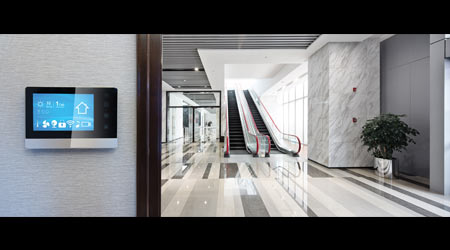 Building technology has grown by leaps and bounds, and current systems should serve as integral components of an FM program.
Building technology has grown by leaps and bounds, and current systems should serve as integral components of an FM program.Best Practices for Implementing Facilities Technology
Use this checklist to help you make decisions regarding selection and deployment of facility technology, from building automation systems to software packages.
Implementations are very system- and customer-specific; there is no simple template that can be applied. However, tips and lessons learned from past installations may help with your next technology project.
Start with a plan. As with any project, successful implementation requires a plan with clearly identified tasks and responsibilities that keep the desired outcome in view. The plan must be realistic and feasible. Recurring meetings with contractor, stakeholders, and consultant/owner-agent should be established, to ensure the project moves forward and maintains appropriate attention.
Realistic schedule. An achievable schedule must be established and approved by stakeholders. Keep in mind hard deadlines and their justification. Account for resource bandwidth and seasonal influences (e.g., holidays and summer vacations).
Consider a phased approach. In many cases, a phased implementation is more manageable; for example, roll-out by campus or building, system or module, departments or users. This also allows for lessons learned and plan improvements to be incorporated with each subsequent phase.
Early adopters. If possible, engage the most likely adopters first, especially if they have been included in the interview process, as they often will offer more grace and provide constructive feedback for improving the roll-out moving forward.
Migrating data. Evaluate quality and comprehensiveness of existing transactional data (e.g., work orders and cost history) to determine if the records are useful and valuable enough to incur the weighty expense of migrating.
Scrub data. Unlike the aforementioned transactional data, static information, such as equipment/asset information, performance characteristics and criteria, and operating and maintenance schedules, are easily imported into the new system. However, before doing such, it is imperative that the data be scrubbed and updated. Typically, it is quicker and easier to review and edit the information in an Excel-compatible format.
Start now. The most common roadblock to achieving targeted milestones is the time sink of data gathering and reviewing/editing, so it is very worthwhile to pursue these efforts during the solicitation process, if not beforehand. If captured in an Excel-compatible format, the information can be easily morphed into the technology import templates, once a system has been selected.
Budget for success. While the cost to procure the technology is often known and budgeted, the cost to implement is typically overlooked or underestimated. This is especially true if significant data clean-up is needed or if data needs to be assembled. It is important to determine who will do this heavy lifting and if they have the bandwidth to get the work done on time. Make sure adequate funding and support is obtained to ensure the project does not flounder or fail to launch.
Solicit support. Given the limited resources and experience within many facility organizations to manage the various aspects of implementation, including data clean-up and entry, it is worth considering outside expertise to assist as an owner’s agent, industry expert, and extra sets of hands through each phase.
Keep selling. The facilities department should always be selling the value of its services. New technology plays a significant role in marketing the department. The selection, implementation, and eventual roll-out of the new system will reflect greatly on the department, so it is imperative that stakeholders at all levels are involved and managed to ensure their support and adoption of the change, as they may be your advocates to their respective teams.
John Rimer (john@fm360consulting.com), CFM, is president of FM360, LLC. In more than 20 years of facility management experience, he has implemented and managed facility programs for companies such as Intel, Microsoft, JP Morgan Chase, and Charles Schwab.
Related Topics:










